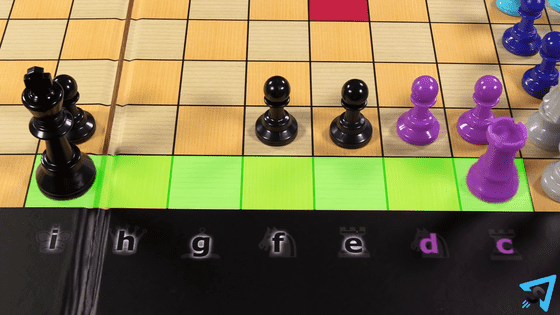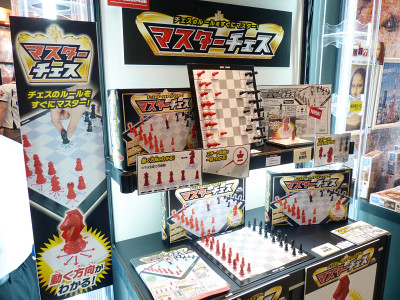Thorough explanation of the rules of ``Sovereign Chess'', a new way of playing super-complicated chess using 112 pieces of 12 colors, ``controlling another piece''

A new way of playing chess that extends the normal chess rules devised by mathematics professor Mark Bates is ' Sovereign Chess 'is. The size of the board is four times the normal size, and 10 colored pieces are added in addition to white and black, and the main point is that 'you will be able to control the pieces of other colors'. Two-player and four-player games are possible, but this time I will explain the rules for two-player games.
SC Rules — Infinite Pi Games
How to play Sovereign Chess-YouTube
◆Board and pieces
Sovereign chess is played on a 16x16 board, whereas it is usually played on an 8x8 board. A total of 112 frames are used, the breakdown of which is as follows.
・Achromatic frame
White, Black: 1 King, 1 Queen, 2 Rooks, 2 Bishops, 2 Knights, 8 Pawns.
Grey, Slate (Dark Grey): 2 Queens, 2 Rooks, 2 Bishops, 2 Knights. Gray and slate pieces are only used in 4-player games.
・Chromatic top
Pink, Red, Orange, Yellow, Green, Cyan, Navy, Violet: 1 Queen, 1 Rook, 1 Bishop, 1 Knight, 4 Pawns.
The layout is shown below. Place white pieces in e1 to l1 and e2 to l2, and black pieces in e15 to l15 and e16 to l16 in the same way as in normal chess. Place the other pieces around the board. Also, the squares near the center of the board are painted with colors corresponding to the pieces, and if you let your piece reach here, you can control the piece corresponding to the color.

by PiGuy216
The color pattern is point symmetrical across the center, so that facing players can reach each color equally. At the start of the game, the player can only move white or black pieces, which are the main colors . Other colors are treated as ' neutral '.
◆Basic rules
The biggest feature of sovereign chess is that you can control pieces of other colors. If you place a piece you control on a colored square, you can control the piece corresponding to the color.
Looking at the image below, you can see that the white pawn is placed on the navy square (e5) and the pink square (i6). Because of this, the white player can control navy and pink pieces in addition to white. Also, since the pink pawn is placed on the cyan square (k9), the white player who controls the pink piece can also control the cyan piece.

Next, let's look at the black coma. The black pawn is on the red square (e12) and the red pawn on the green square (k11), so the black player can control the black, red and green pieces. state. Note that the black queen is placed on the white square in the center, but the white piece is the main color of the white player, so the black player cannot take control.

There are some important rules for controls. The first is that 'If you remove a frame from a colored square, you lose control of the frame.' For example, with a white piece on a navy square and a navy piece on a red square, if you move a white piece from a navy square, navy loses control. At the same time, you will also lose control of the red piece that was controlled by the navy piece.
The other is that 'If a piece is placed on a certain color square, it cannot be placed on another square of the same color.' This is the same whether you are placing a piece or your opponent.For example, in the following case, the black pawn is placed on the red square (e12), so the white player has another red square (l5) I can't put a piece on In order for the white player to control the red piece, either wait until the opponent removes the piece from e12, or go to take the piece of e12 with his own piece.

The last rule is 'You can not put a frame on the same color square as the frame'. As an example, Luke is at a distance where he can take the opponent's (white) king as shown below, but he cannot actually take the king because of the rule that black pieces cannot be placed on black squares.

In addition, restrictions are imposed on the action of 'taking frames'. Each player can only take ``pieces controlled by the other party'', and cannot take pieces that are not controlled by anyone, or take pieces that are controlled by themselves.
◆ How to move the frame
The movement of pieces is basically the same as in normal chess. However, at the beginning of the game, the first player always moves the white piece first, and the second player chooses whether to play as black or as white. If you choose black, move the black frame as usual. If you choose white, you accept the pieces that your opponent has moved, give the turn to your opponent, and then move the pieces in turn as usual. The winner is the player who checkmate the king controlled by the opponent.
Queens, bishops, and rooks can only move up to 8 squares ahead. You cannot move more than 8 squares.

Pawns have the most complex movements. Normally, it is a pawn that can only move forward (straight forward / diagonally forward), but sovereign chess allows ``forward or lateral movement''. However, the constraint that 'always move toward the center' is imposed.
The Sovereign Chess board has a cross-shaped brown auxiliary line as shown in the red frame below. A pawn must follow this extension line to stay in the center and cannot move beyond the extension line. However, the movement of 'taking the opponent's piece' is an exception, and only in this case it is possible to move beyond the auxiliary line.

Also, pawns usually have the characteristic of being able to move up to 2 squares only ``when moving for the first time'', but in sovereign chess, ``the pawn is on the outermost circumference (a1-p1, a16-p16, a1-a16, p1-p16) or It can move up to 2 squares only if it is located one inner circle (b2-o2, b15-o15, b2-b15, o2-o15) and moved away from the nearest edge of the board.

Below is an example of how to move a pawn. The pawn in red frame 1 is adjacent to the auxiliary line and can only move in a direction that does not cross the auxiliary line and does not leave the center as indicated by the white arrow. However, as indicated by the black arrows, you can cross the auxiliary lines only when capturing other frames. The pawn in red frame 2 is located one circle inside the outermost circle, so it can move 2 squares only if it leaves the nearest edge of the board (in this case, the front).

When a pawn reaches the central 4x4 square, it must be
En passant is forbidden in sovereign chess.
Castling can be done with rooks and kings in the same rank (row) as normal, and can be done with other colors if you control them.

◆Regime change
Erasing the original king and giving birth to another king is called 'regime change'. There are three types of Regime Change: Coup , Overthrow , and Defection .
·coup d'état
Refers to the aforementioned promotion (consisting).
・Capsize
When a player promotes with a pawn other than their main color, they can be promoted to a king of the same color as that pawn. This is called 'overthrow', and the color of the promoted king from then on becomes the player's main color. Then, the king that was in control until then is immediately removed from the board. You can always control the piece that has become the main color, even if you remove the piece from the main color square, you can continue to control it. However, the pieces of the main color that had been controlled until then will be out of your control.
·exile
Changing the king you control to a different color king you control is called 'exile'. Deportation can be done only on your turn instead of moving pieces, and your turn ends when you have defected once. There is no limit to the number of times you can declare asylum in one game. Also, changing the king due to defection does not count against the castling rule ``that the king has not moved once'', so if you have not moved the king and rook from the position at the beginning of the game, defection It is possible to castling after doing
In addition, there may be a pattern that 'a piece stands in the same color square by exile'. For example, if you put a black king on an orange square to take control of the orange, then change the king from black to orange. In this case, the orange king is standing on the orange square, so the orange king must move immediately. If you can't move, you can't declare asylum.

The idea of 'main color' mentioned above is important in regime change. In the previous diagram, I explained that ``Since the white piece is the white player's main color, even if the black player puts a piece on the white square, he cannot take control of the white piece.'' did. However, if the white player overthrows or defectes and uses another color as the main color, the white piece that has served as the main color until then leaves the hand, so the black player is no longer the main color. can be controlled. In order for the white player to regain control of the white piece, he must place his piece on the white square.

If you checkmate the opponent's king according to the above rules, you win the game.
The sovereign chess board and pieces can be purchased from the

Related Posts:







